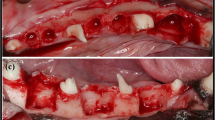Abstract
In order to understand the requirements of guided bone regeneration (GBR) involving alginate base self-setting barrier membranes, GBR was performed in the case of bicortical bone defects formed at the tibiae of experimental animals employing self-setting and ready-made alginate membranes. Connective tissue ingress into the bone defects at the skin side of the tibia was observed when GBR was generated utilizing ready-made alginate membrane. In contrast, bone defects were reconstructed with bone tissue when GBR was generated with self-setting alginate membrane formed from aqueous 3% sodium alginate and 3% CaCl2 solutions. The unreacted aqueous sodium alginate solution inherent to self-setting alginate membrane did not inhibit bone tissue regeneration. Rather, callus bone was formed using sodium alginate as the nucleus. However, when GBR was effected with self-setting alginate membrane formed from aqueous 10% CaCl2 solution, membrane was too thick and thus regeneration of bone tissue in the bone cavity was prevented. Therefore, we concluded that self-setting alginate membrane is very useful as a barrier membrane for GBR upon appropriate adjustment of conditions with respect to preparation of alginate membrane.
Similar content being viewed by others
References
K. ISHIKAWA, Y. UEYAMA, T. MANO, T. KOYAMA, K. SUZUKI, T. and T. MATSUMURA, J. Biomed. Mater. Res. 47(2) (2002) 111.
Y. UEYAMA, K. ISHIKAWA, T. MANO, T. KOYAMA, H. NAGATSUKA, K. SUZUKI and K. RYOKE, Biomaterials 23(9) (2002) 2027.
J. H. LEE, W. G. KIM, S. S. KIM, J. H. LE and H. B. LEE, J. Biomed. Mate. Res. 36(2) (1997) 200.
S. H. YUK, S. H. CHO and H. B. LEE, Pharm. Res. 9(7) (1992) 955.
A. LINDE, P. ALBERIUS, C. DAHLIN, K. BJURSTAM and Y. SUNDIN, J. Periodontol 64(11) (1993) 1116.
M. SIMION, A. SCARANO, L. GIONSO and A. PIATTELLI, Int. J. Oral. Maxillofac. Implants. 11(6) (1996) 735.
J. T. MELLONIG, M. NEVINS and R. SANCHEZ, Int. J. Periodont. Rest. Dent. 18(2) (1998) 129.
B. BOYCE, in “Biologic and Synthetic Vascular Prostheses,” J. C. Stanly (ed), (Grune & Stratton, New York, 1982) p. 555.
Author information
Authors and Affiliations
Corresponding author
Rights and permissions
About this article
Cite this article
Ueyama, Y., Koyama, T., Ishikawa, K. et al. Comparison of ready-made and self-setting alginate membranes used as a barrier membrane for guided bone regeneration. J Mater Sci: Mater Med 17, 281–288 (2006). https://doi.org/10.1007/s10856-006-7315-1
Received:
Accepted:
Issue Date:
DOI: https://doi.org/10.1007/s10856-006-7315-1




